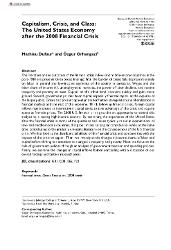| dc.contributor.author | Dufour, Mathieu | |
| dc.contributor.author | Orhangazi, Özgür | |
| dc.date.accessioned | 2019-06-27T08:02:43Z | |
| dc.date.available | 2019-06-27T08:02:43Z | |
| dc.date.issued | 2014 | |
| dc.identifier.issn | 0486-6134 | en_US |
| dc.identifier.issn | 1552-8502 | en_US |
| dc.identifier.uri | https://hdl.handle.net/20.500.12469/672 | |
| dc.identifier.uri | https://doi.org/10.1177/0486613414537981 | |
| dc.description.abstract | The literature on the outcomes of the financial crisis in low- and middle-income countries in the post-1980 era presents three broad findings: first the burden of crises falls disproportionately on labor in general and low-income segments of the society in particular. Wages and the labor share of income fall unemployment increases the power of labor declines and income inequality and poverty increase. Capital on the other hand recovers quickly and gains more ground. Second government policies favor capital especially financial capital at the expense of the larger public. Crises also present opportunities for further deregulation and liberalization in financial markets and the rest of the economy. Third following financial crises foreign capital inflows may increase as international capital seeks to take advantage of the crisis and acquire assets at fire-sale prices. The 2008 U.S. financial crisis provides an opportunity to extend this analysis to a leading high-income country. By examining the experience of the United States after the financial crisis in terms of the questions and issues typically raised in examinations of low- and middle-income countries this paper makes an original contribution while at the same time contributing to the gradually emerging literature on the consequences of the U.S. financial crisis. We first look at the distributional effects of the financial crisis and compare this with the impacts of the crisis on capital. Then we investigate the changes in income shares of labor and capital before shifting our attention to changes in inequality and poverty. Next we focus on the role of government policies through an analysis of government taxation and spending policies. Finally we examine the changes in capital inflows before concluding with a discussion of our overall findings and further research areas. | en_US] |
| dc.language.iso | eng | en_US |
| dc.publisher | Sage Publications Inc | en_US |
| dc.rights | info:eu-repo/semantics/openAccess | en_US |
| dc.subject | Financial crisis | en_US |
| dc.subject | Great Recession | en_US |
| dc.subject | 2008 crisis | en_US |
| dc.subject | G01 | en_US |
| dc.subject | D31 | en_US |
| dc.subject | E62 | en_US |
| dc.subject | F21 | en_US |
| dc.title | Capitalism Crisis and Class: The United States Economy after the 2008 Financial Crisis | en_US |
| dc.type | article | en_US |
| dc.identifier.startpage | 461 | en_US |
| dc.identifier.endpage | 472 | |
| dc.relation.journal | Review of Radical Political Economics | en_US |
| dc.identifier.issue | 4 | |
| dc.identifier.volume | 46 | en_US |
| dc.department | Fakülteler, İktisadi, İdari ve Sosyal Bilimler Fakültesi, Ekonomi Bölümü | en_US |
| dc.identifier.wos | WOS:000344690300004 | en_US |
| dc.identifier.doi | 10.1177/0486613414537981 | en_US |
| dc.identifier.scopus | 2-s2.0-84921527189 | en_US |
| dc.institutionauthor | Orhangazi, Özgür | en_US |
| dc.relation.publicationcategory | Makale - Uluslararası Hakemli Dergi - Kurum Öğretim Elemanı | en_US |
















